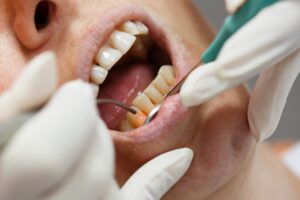 Cavities aren’t the only threat to your oral health. Did you know that gum disease is also a leading cause of tooth loss? The Centers for Disease Control and Prevention reports that at least 50% of adults have a form of gum disease. Not only can it wreak havoc on your dental health, but it can also affect your general wellness negatively. Laser dentistry has revolutionized gum disease treatment. Here’s how you can benefit from the pinpoint accuracy of a dental laser to stop the infection in its tracks.
Cavities aren’t the only threat to your oral health. Did you know that gum disease is also a leading cause of tooth loss? The Centers for Disease Control and Prevention reports that at least 50% of adults have a form of gum disease. Not only can it wreak havoc on your dental health, but it can also affect your general wellness negatively. Laser dentistry has revolutionized gum disease treatment. Here’s how you can benefit from the pinpoint accuracy of a dental laser to stop the infection in its tracks.
What Causes Gum Disease?
Gum disease is an infection that’s almost always caused by poor oral hygiene. Improper brushing and flossing habits can allow plaque to accumulate near your gum line. It harbors harmful oral bacteria that will inflame and irritate the tissue.
Initially, you can experience red, swollen, and bleeding gums. This is the first stage of gum disease, called gingivitis, which is easy to treat if you act fast. With no treatment, gingivitis can progress to advanced periodontitis, which can destroy the supporting structures of your teeth. Bacteria from the infection can also enter your bloodstream through the pressure of regular chewing. This can increase your risk of several health issues, including cardiovascular disease, Alzheimer’s, and diabetes.
Gum Disease and Laser Dentistry
Scaling and root planing have been used for decades to treat gum disease. Although they are effective, modern technology offers better results. The soft tissue laser targets diseased tissue to eradicate the infection. The laser will kill over 99% of oral bacteria while encouraging the regeneration of healthy tissue.
You’ll benefit from a less invasive treatment that will reduce your risk of postoperative bleeding, swelling, and infections. The laser will remove damaged tissue without harming your healthy gums. Your gums will adhere to your tooth roots to seal out harmful bacteria.
How to Keep Your Gums Healthy
You can protect your smile from gum disease with good oral hygiene. Brush your teeth at least twice a day for 2 minutes and floss daily. Brushing isn’t enough to keep your gums healthy because your toothbrush can’t reach everywhere, like between teeth. Flossing is the only way to remove food residue and plaque from hard-to-reach areas. Finish your oral hygiene routine with an antimicrobial mouthwash.
Schedule a cleaning and checkup with your dentist every 6 months. They’ll monitor your smile for any changes, like gum inflammation, to provide quick intervention to stop the issue from worsening. If you have symptoms of gum disease, don’t settle for less than the best. Choose a dentist that offers laser gum therapy.
About Dr. Jodi Meadvin
Dr. Meadvin earned her dental degree at the University of Pennsylvania School of Medicine and has continued her education in many specialties, including general dentistry, cosmetic dentistry, and periodontal therapy. She is a proud member of the New Jersey Dental Association and the American Dental Association. Request an appointment through her website or call her office at (856) 281-3437.
